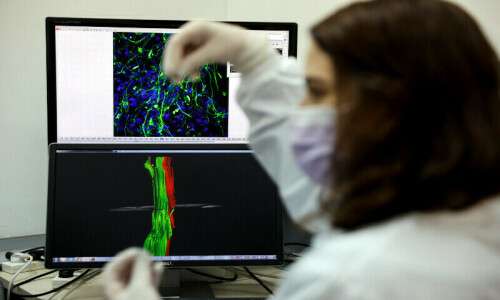Stem Cell Therapy Offers Hope for Spinal Cord Injury Patients
TOKYO: A pioneering study conducted by Japanese researchers has demonstrated that stem cell therapy can enhance motor function in patients suffering from spinal cord injuries. The trial, the first of its kind, showed improvements in two out of four participants following treatment.
Currently, there is no widely available cure for paralysis resulting from severe spinal cord damage, which affects over 150,000 individuals in Japan, with approximately 5,000 new cases reported annually.
A research team at Keio University in Tokyo is exploring the potential of induced pluripotent stem cells (iPS)—reprogrammed mature cells that have been reverted to an embryonic-like state. These cells can be directed to develop into various specialized cell types, and in this study, the researchers utilized iPS-derived neural stem cells.
On Friday, Keio University announced that two patients exhibited enhanced motor function scores after receiving over two million iPS-derived neural stem cells implanted into their spinal cords.
Crucially, no significant adverse effects were observed in any of the four cases after one year of careful monitoring. While the primary objective of the study was to assess the safety of the procedure, the observed functional improvements offer promising implications for future treatments.
According to Japan’s public broadcaster NHK, one of the two patients who experienced improvement was an elderly man who had sustained his spinal cord injury in an accident.
Frequently Asked Questions (FAQs)
- What is induced pluripotent stem cell (iPS) therapy?
iPS therapy involves reprogramming adult cells to return to an immature state, allowing them to be developed into different types of specialized cells, such as neural stem cells. - How does stem cell therapy help spinal cord injuries?
By introducing neural stem cells into the damaged spinal cord, the treatment aims to regenerate nerve function and promote recovery in patients with spinal cord injuries. - Did all patients in the study show improvement?
While all four patients were monitored for safety, only two exhibited noticeable improvements in their motor function scores. - Were there any side effects of the treatment?
No serious adverse reactions were reported in any of the patients during the one-year follow-up period. - Is stem cell therapy for spinal cord injuries widely available?
Currently, this treatment is still in the research phase and has not yet been made widely accessible. More studies are required to confirm its effectiveness and safety for broader use.
ALSO READ
https://flarenews.pk/2025/03/23/new-zealand-crush-pakistan-with-record-115/



